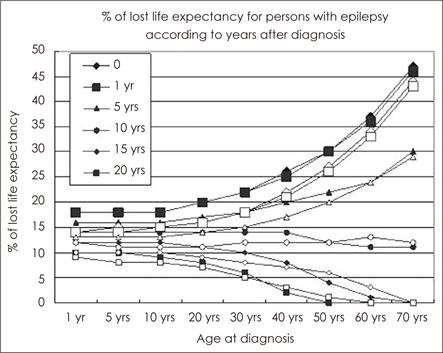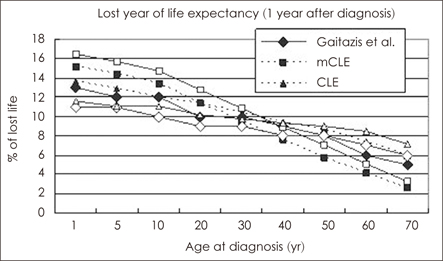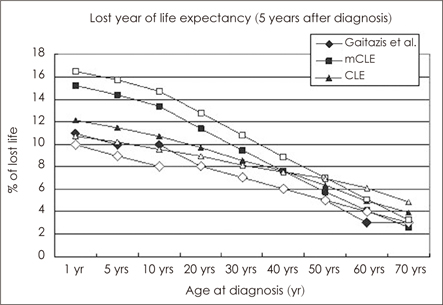J Korean Neurotraumatol Soc.
2011 Apr;7(1):8-11. 10.13004/jknts.2011.7.1.8.
Estimation of the Life Expectancy for the Posttraumatic Epilepsy in Korea
- Affiliations
-
- 1Department of Neurosurgery, Cheonan Hospital, College of Medicine, Soonchunhyang University, Cheonan, Korea. ksleens@schmc.ac.kr
- KMID: 1427646
- DOI: http://doi.org/10.13004/jknts.2011.7.1.8
Abstract
OBJECTIVE
The life expectancy (LE) would be short among persons with epilepsy. To what extent the life span is shortened is, however, controversial. Since the statistics of the LE increases year by year, we should update the ratio of expected life based on the recent data.
METHODS
We searched articles on the LE and mortality of the epilepsy. Data from the literature review and the life table of Korean National Statistical Office, we proposed a scheme estimating the LE for persons with posttraumatic epilepsy.
RESULTS
Gaitazis et al. reported the average percentage of lost LE would be 25.9% for male, 22.2% for female at 1 year after diagnosis. It would be decreased year by year, being 5.0% for male and 4.6% for female at 20 years after diagnosis. There was a significant difference between Gaitazis et al.'s data and the mean calculated LE according to the Lee's scheme. The calculated LE, applied Gaitazis et al.'s percentage to the Korean life table was more closer to Gaitazis et al.'s data. We proposed a table showing percentage of normal life expectancy lost following diagnosis of posttraumatic epilepsy using Gaitazis et al.'s table.
CONCLUSION
For updated estimation of the individual LE for persons with posttraumatic epilepsy, we proposed a percentage table showing the lost life expectancy.
Figure
Reference
-
1. Bowman SM, Aitken ME, Sharp GB. Disparities in hospital outcomes for injured people with epilepsy/seizures. Epilepsia. 2010; 51:862–867.
Article2. Englander J, Bushnik T, Wright JM, Jamison L, Duong TT. Mortality in late post-traumatic seizures. J Neurotrauma. 2009; 26:1471–1477.
Article3. Frey LC. Epidemiology of posttraumatic epilepsy: a critical review. Epilepsia. 2003; 44:Suppl 10. 11–17.
Article4. Gaitatzis A, Johnson AL, Chadwick DW, Shorvon SD, Sander JW. Life expectancy in people with newly diagnosed epilepsy. Brain. 2004; 127:2427–2432.
Article5. Hauser WA, Annegers JF, Elveback LR. Mortality in patients with epilepsy. Epilepsia. 1980; 21:399–412.
Article6. Hitiris N, Mohanraj R, Norrie J, Brodie MJ. Mortality in epilepsy. Epilepsy Behav. 2007; 10:363–376.
Article7. Kwan P, Sander JW. The natural history of epilepsy: an epidemiological view. J Neurol Neurosurg Psychiatry. 2004; 75:1376–1381.
Article8. Lee KS. Medical Consideration on the Reparation and Compensation. ed 4. Seoul: Joongangmunhwasa;2001. p. 227–253.9. Lhatoo SD, Johnson AL, Goodridge DM, MacDonald BK, Sander JW, Shorvon SD. Mortality in epilepsy in the first 11 to 14 years after diagnosis: multivariate analysis of a long-term, prospective, population-based cohort. Ann Neurol. 2001; 49:336–344.
Article10. Lhatoo SD, Sander JW. Cause-specific mortality in epilepsy. Epilepsia. 2005; 46:Suppl 11. 36–39.
Article11. Nilsson L, Farahmand BY, Persson PG, Thiblin I, Tomson T. Risk factors for sudden unexpected death in epilepsy: a case-control study. Lancet. 1999; 353:888–893.12. Rakitin A, Liik M, Oun A, Haldre S. Mortality risk in adults with newly diagnosed and chronic epilepsy: a population-based study. Eur J Neurol. 2011; 18:465–470.
Article13. Shafer SQ, Hauser WA, Annegers JF, Klass DW. EEG and other early predictors of epilepsy remission: a community study. Epilepsia. 1988; 29:590–600.
Article14. Sperling MR, Harris A, Nei M, Liporace JD, O'Connor MJ. Mortality after epilepsy surgery. Epilepsia. 2005; 46:Suppl 11. 49–53.
Article15. Tomson T. Mortality in epilepsy. J Neurol. 2000; 247:15–21.
Article16. Walker AE, Blumer D. The fate of World War II veterans with posttraumatic seizures. Arch Neurol. 1989; 46:23–26.
Article17. Walker MC. The attitude of courts in England to compensation for post-traumatic epilepsy. Seizure. 2001; 10:203–207.
Article18. Zieliński JJ. Epilepsy and mortality rate and cause of death. Epilepsia. 1974; 15:191–201.
Article
- Full Text Links
- Actions
-
Cited
- CITED
-
- Close
- Share
- Similar articles
-
- Life Expectancy of The Posttraumatic Persistent Vegetative State: Review of Literature and A Proposal
- Estimation of the Life Expectancy for The disabled Persons after Head Injury
- An Expert Opinion on the Life Expectancy after Traumatic Brain Injury
- Erratum - Standardized multi-institutional data analysis of fixed and removable prosthesis: estimation of life expectancy with regards to variable risk factors
- A Review of the Types and Characteristics of Healthy Life Expectancy and Methodological Issues




